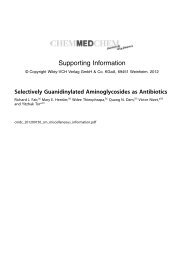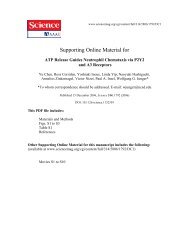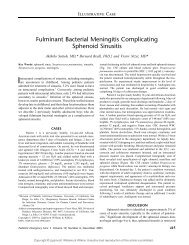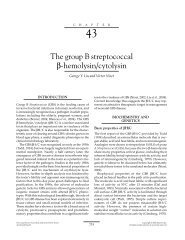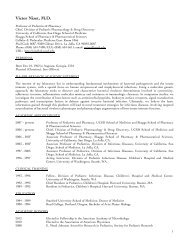BACTERIAL SEPSIS AND MENINGITIS - Nizet Laboratory at UCSD
BACTERIAL SEPSIS AND MENINGITIS - Nizet Laboratory at UCSD
BACTERIAL SEPSIS AND MENINGITIS - Nizet Laboratory at UCSD
You also want an ePaper? Increase the reach of your titles
YUMPU automatically turns print PDFs into web optimized ePapers that Google loves.
SERRATIA MARCESCENS<br />
Similar to other members of Enterobacteriaceae, Serr<strong>at</strong>ia<br />
marcescens increasingly is associ<strong>at</strong>ed with hospitalacquired<br />
infections in infants in the NICU [158–160].<br />
L<strong>at</strong>e-onset sepsis has occurred in infants infected from<br />
health care equipment [160–163], the hands of he<strong>at</strong>h care<br />
workers [164], milk bottles [159], aqueous solutions such<br />
as theophylline [159], hand hygiene washes [160], and<br />
lipid parenteral feeds [162]. The gastrointestinal tracts<br />
of hospitalized infants provide a reservoir for transmission<br />
and infection [161]. Investig<strong>at</strong>ion of an outbreak of multidrug-resistant<br />
S. marcescens in the NICU identified exposure<br />
to inhal<strong>at</strong>ional therapy as an independent risk factor<br />
for acquisition [165].<br />
In a review by Campbell and colleagues [166] of neon<strong>at</strong>al<br />
bacteremia and meningitis caused by S. marcescens, 11<br />
(29%) of 38 infants had meningitis as a complic<strong>at</strong>ion of<br />
bacteremia. Mean gest<strong>at</strong>ional age was 28 weeks, and mean<br />
birth weight was 1099 g. All p<strong>at</strong>ients required mechanical<br />
ventil<strong>at</strong>ion, 90% had central venous c<strong>at</strong>heters in situ, 90%<br />
had received prior antibiotics, 50% had a prior intraventricular<br />
hemorrhage, 40% had a hemodynamically significant<br />
p<strong>at</strong>ent ductus arteriosus tre<strong>at</strong>ed medically or<br />
surgically, and 20% had necrotizing enterocolitis with<br />
perfor<strong>at</strong>ion. All p<strong>at</strong>ients were tre<strong>at</strong>ed for a minimum of<br />
21 days with combin<strong>at</strong>ion antimicrobial therapy th<strong>at</strong><br />
included a third-gener<strong>at</strong>ion cephalosporin or a ureidopenicillin<br />
and an aminoglycoside, typically gentamicin.<br />
Three of 10 p<strong>at</strong>ients died. Four of the seven survivors<br />
developed severe hydrocephalus requiring ventriculoperitoneal<br />
shunt placement and had poor neurologic outcome.<br />
Poor neurologic outcome also was documented<br />
in a report of S. marcescens brain abscess resulting in<br />
multicystic encephalomalacia and severe developmental<br />
retard<strong>at</strong>ion [167].<br />
PSEUDOMONAS AERUGINOSA<br />
P. aeruginosa usually is a cause of l<strong>at</strong>e-onset disease in<br />
infants who are presumably infected from their endogenous<br />
flora or from equipment, aqueous solutions, or occasionally<br />
the hands of health care workers. An outbreak of<br />
P. aeruginosa sepsis in a French NICU was associ<strong>at</strong>ed with<br />
contamin<strong>at</strong>ion of a milk bank pasteurizer [168]. Stevens<br />
and colleagues [169] reported nine infants with Pseudomonas<br />
sepsis, four of whom presented in the first 72 hours of<br />
life. In three of these infants, the initial signs were of<br />
respir<strong>at</strong>ory distress, and chest radiographs were consistent<br />
with hyaline membrane disease. Noma (i.e., gangrenous<br />
lesions of the nose, lips, and mouth) in a neon<strong>at</strong>e has been<br />
associ<strong>at</strong>ed with bacteremia caused by P. aeruginosa [170].<br />
A retrospective review of sepsis in infants admitted over<br />
the 10-year period 1988-1997 to the NICU <strong>at</strong> Children’s<br />
Hospital of the King’s Daughters in Norfolk, Virginia,<br />
identified 825 cases of l<strong>at</strong>e-onset sepsis [14]. Infants with<br />
Pseudomonas sepsis had the highest frequency of clinically<br />
fulminant onset (56%), and 20 of the 36 (56%) infants<br />
with Pseudomonas sepsis died within 48 hours of collection<br />
of blood culture.<br />
P. aeruginosa conjunctivitis in the neon<strong>at</strong>e is a danger<br />
because it is rapidly destructive to the tissues of the eye<br />
and because it may lead to sepsis and meningitis. Shah<br />
CHAPTER 6 Bacterial Sepsis and Meningitis<br />
235<br />
and Gallagher [171] reviewed the course of 18 infants <strong>at</strong><br />
Yale–New Haven Hospital NICU who had P. aeruginosa<br />
isol<strong>at</strong>ed from cultures of the conjunctiva during 10 years<br />
beginning in 1986. Five infants developed bacteremia,<br />
including three with meningitis, and two infants died.<br />
More recently, a cluster of four f<strong>at</strong>al cases of P. aeruginosa<br />
pneumonia and bacteremia among neon<strong>at</strong>es was traced<br />
by genotypic fingerprinting to their shared exposure to<br />
a health care worker experiencing intermittent otitis<br />
externa [172].<br />
SALMONELLA SPECIES<br />
Non-Typhi Salmonella infection is an uncommon cause of<br />
sepsis and meningitis in neon<strong>at</strong>es, but a significant proportion<br />
of cases of Salmonella meningitis occur in young<br />
infants. The CDC observed th<strong>at</strong> approxim<strong>at</strong>ely one third<br />
of 290 Salmonella isol<strong>at</strong>es from CSF reported during<br />
1968-1979 were from p<strong>at</strong>ients younger than 3 months,<br />
and more than half were from infants younger than 1 year<br />
[173]. A 21-year review of gram-neg<strong>at</strong>ive enteric meningitis<br />
in Dallas beginning in 1969 identified Salmonella as the<br />
cause in 4 of 72 cases [23]. Investig<strong>at</strong>ors from Turkey<br />
reported seven cases of neon<strong>at</strong>al meningitis caused by<br />
Salmonella during the years 1995-2001 [174]. Two of the<br />
five survivors developed communic<strong>at</strong>ing hydrocephalus,<br />
and one had a subdural empyema. In a case of neon<strong>at</strong>al<br />
meningitis caused by Salmonella enterica serotype Ancona,<br />
the p<strong>at</strong>hogen was isol<strong>at</strong>ed simultaneously from the<br />
newborn’s CSF, parental fecal samples, and the mother’s<br />
breast milk [175].<br />
Reed and Klugman [176] reviewed 10 cases of neon<strong>at</strong>al<br />
typhoid th<strong>at</strong> occurred in a rural African hospital. Six of<br />
the infants had early-onset sepsis with acquisition of the<br />
organism from the m<strong>at</strong>ernal genital tract, and four had<br />
l<strong>at</strong>e-onset infection with acquisition from a carrier or<br />
an environmental source. Two neon<strong>at</strong>es developed<br />
meningitis, and three died.<br />
NEISSERIA MENINGITIDIS<br />
Although N. meningitidis is a leading cause of bacterial<br />
sepsis and meningitis among children and adolescents,<br />
it rarely is associ<strong>at</strong>ed with invasive infection in neon<strong>at</strong>es<br />
[12, 26, 177]. N. meningitidis may colonize the female genital<br />
tract [178–180] and has been associ<strong>at</strong>ed with pelvic<br />
inflamm<strong>at</strong>ory disease [181]. The infant can be infected<br />
<strong>at</strong> delivery by organisms present in the m<strong>at</strong>ernal genital<br />
tract, or intrauterine infection can result during m<strong>at</strong>ernal<br />
meningococcemia [182]. Meningococcal sepsis is rare in<br />
neon<strong>at</strong>es, but more than 50 cases (including 13 from the<br />
preantibiotic era) have been described [183–185]. Earlyonset<br />
and l<strong>at</strong>e-onset forms [178, 179, 185] of meningococcal<br />
sepsis in neon<strong>at</strong>es have been reported. Purpura similar<br />
to meningococcemia in older children has been observed<br />
in a 15-day-old infant [186] and a 25-day-old infant [187].<br />
Shepard and colleagues [185] from the CDC reported<br />
22 neon<strong>at</strong>es with invasive meningococcal disease from a<br />
10-year active, popul<strong>at</strong>ion-based surveillance of 10 st<strong>at</strong>es<br />
with diverse popul<strong>at</strong>ions and more than 31 million persons.<br />
The average annual incidence was 9 cases per<br />
100,000 people (versus 973.8 per 100,000 for GBS).<br />
Sixteen p<strong>at</strong>ients had meningitis, and 6 of these also had



